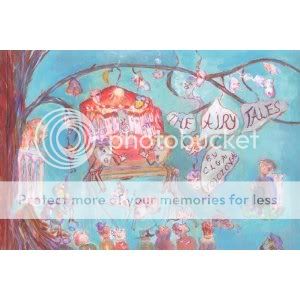The Airy Tales
Olga Volozova, writer/artist
Sparplug, 2008
128 pages
$15
Like some of the other Sparkplug titles I’ve sampled–Inkweed comes to mind–The Airy Tales, Olga Volozova’s collection of original short fairy tales and fables, is a tough sell at first glance. And as I’ve often said, first glance is precisely where I buy or pass. There are too many comics and too few hours in the day to force myself to plow through a book I don’t find appealing on an art-surface level. Every once in a while an imprint will come along whose guiding aesthetic, and this is nobody’s fault, simply has little Venn-diagram overlap with mine. First Second is one; Sparkplug seems at times to be another. But then for whatever reason–usually because I’m up against a self-imposed deadline and the book looks short enough to read on the train– I’ll say “What the hell,” take it off the shelf, give it a read, and exit gladder for having done so.
Such is the case with The Airy Tales. Like Inkweed, its visuals aren’t really too my taste. Volozova’s shaky line and mixed media elements come across a little bit Stieg, a little bit Salazar, and a lot alien from where I’m at. The painted colors read craft-y rather than considered, the character designs are too wishy-washy to stand out the way the great illustrated children’s-book characters do, and the placement of captions in particular is a detriment to readability. It’s clear Volozova’s intent is to combine the sequential storytelling of comics with the static image-and-text approach of a child’s storybook, but her solution–placing the text in little boxes surrounding the central image that are sometimes read from top to bottom and sometimes read from left to right–is confusing even to someone who got his altcomix start with Acme Novelty Library.
This leaves the writing to do most of the work–and it works. I really have to hand it to Volozova for capturing the ineffable quality of fairy tales before Disney simplified them into plucky can-do adventures. The recurring images bear the mark of springing unbidden and unexplained from her underbrain, whether it’s giant celestial birds using tiny threads thousands of miles long to guide each individual human around the Earth or a man made of rain who uses his godlike powers of growth to make the lives of the people who come to him for help just slightly better than before. Most of the time you get the sense that there’s some moral to the story, but it’s a, well, weird moral, a moral based on the moral-ity of an age or society lost to us. Like, there’s this one extended fable about a group of people who each live on a different leaf of a tree that sheds those leaves every day, only for them to drift back onto the tree each night. All the residents have full lives except this one guy whose sole possession is a bright yellow sweater; since his leaf isn’t burdened with family members or fun stuff, he ends up higher on the trunk every day, and his neighbors get jealous. Finally he catches on and deliberately builds a contraption to lower himself down to their level, and they’re all finally happy, and you think it’s a crabs-in-the-pot-type parable about how livin’ free means living outside society, or whatever. But then the story ends by telling us only the yellow-sweater man knew that in fact the leaves were never gonna re-attach to the tree again, because of the impending snowfall–and then the snowfall comes and each snowflake contains a little kid or animal cub. And that’s it! That’s the end. As Zak Smith recently said, the wonderful thing about Wonderland is that it makes you wonder; The Airy Tales certainly left me scratching my head. It’s alien from me in both the bad way and the good way.
Tags: comics, comics reviews, Comics Time, reviews

